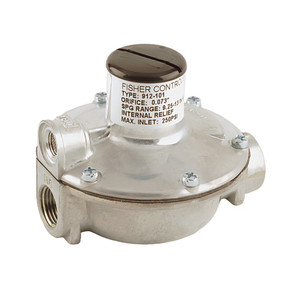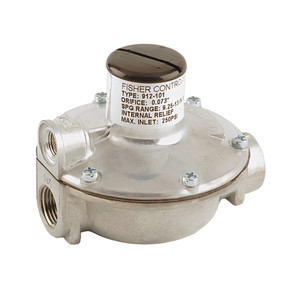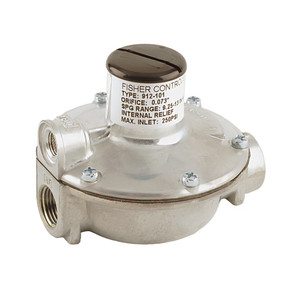912 Series direct-operated, spring-loaded regulators are Underwriters Laboratory (UL) listed regulators used in a variety of service and industrial applications. These regulators have limited-capacity internal relief across the diaphragm to help minimize overpressure. Designed for use on small portable outdoor appliances.
Features
- Accurate, Sensitive Control
- Vent Over Outlet
- Weather and Insect Protection
- Easy Maintenance
- UL Listed
Specifications
- Capacity (Propane): 101,000 BTU/HR
- Inlet Connection: 1/4 in. FNPT
- Outlet Connection: 1/4 in. FNPT
- Material: Zinc Alloy
- Vent is Over the Outlet
- Orifice Size: 0.073 in. (1.85mm)
- Maximum Inlet Pressure: 250 psig/17,2 bar
- Maximum Emergency Outlet Pressure: 20 psig/1,4 bar
- Outlet Pressure Ranges: 9.25 - 13 in. w.c. / 23 -32 mbar
- Pressure Registration: Internal
- Temperature Capabilities: -20° to 160°F / -29° to 71°C
Warning
Warning: Only qualified personnel should install or service a regulator. Regulators should be installed, operated, and maintained in accordance with international and applicable codes and regulations, and Fisher instructions. If the regulator vents fluid or a leak develops in the system, it indicates that service is required. Failure to take the regulator out of service immediately may create a hazardous condition Personal injury, equipment damage, or leakage due to escaping fluid or bursting of pressure containing parts may result if this regulator is over pressured or is installed where service conditions could exceed the limits given in the Specifications section, or where conditions exceed any ratings of the adjacent piping or piping connections. To avoid such injury or damage, provide pressure relieving or pressure-limiting devices (as required by the appropriate code, regulation, or standard) to prevent service conditions from exceeding limits. Additionally, physical damage to the regulator could result in personal injury and property damage due to escaping fluid. To avoid such injury and damage, install the regulator in a safe location.
Downloads
Emerson Fisher 912 & 912H Installation Guide (PDF Download)
Emerson Fisher Single - Second Stage LP Gas Regulators - Manual (PDF Download)












